
Even though my family isn’t homeschooling this year, All About Spelling and the complementary All About Reading programs still figure prominently in our “afterschooling” routine.In just 15-20 minutes a day, two or three days a week, I can work with my 4th grader to augment her learning, or — over the summer — to keep her skills strong.
If you’re interested in reading more about what we did in our homeschool, please check out these posts.
When I decided to start posting more about our homeschooling, one of the first things I knew I wanted to write about was the fabulous, amazing, incredible (can you tell I like it?!) program that we use to teach spelling with our 2nd grader.
It’s called All About Spelling and it comes from the team at All About Learning. Whether you are a homeschooler or an afterschooler, All About Spelling is an amazing program to use with any student — and especially with those who struggle with spelling.
What’s Different About the All About Spelling Program?
#1. What They Learn Is Different
I’m pretty sure that most kids today – whether they are homeschooled or not – are learning spelling much the same way I learned spelling 30 years ago. They take a pretest on Monday, memorize a list of 20 or so words from Tuesday thru Thursday, and then take a final test on Friday.
Good spellers will do well; they may only have to “learn” two or three words each week. Most kids can handle memorizing a few words in the course of a week — and with any luck, 50% of those spellings will stick.
But for kids who struggle with spelling, this method is worthless. I have certainly seen this to be the case, time and again, with my own child. He might manage to memorize the words for the “test”, but by the following Monday, all is forgotten.
All About Spelling takes a completely different approach. Instead of just memorizing words, kids learn a system for spelling. All About Spelling then breaks down those systems, piece by piece, starting with the very foundations of the English language – the sounds that each letter makes.
Students learn not only how to spell a particular word — but why it’s spelled that way! Now, as a fluent reader, you probably know all of this intuitively, but would you be able to break it down into bite-size pieces?
Those bite-size pieces are so essential for a student who’s struggling. They can’t be expected to intuit the rules of spelling; they need it to be taught to them explicitly.
Let me give you an example. We all know that the silent ‘e’ at the end of the word makes the preceding vowel sound long (like in the word “make”), but did you know that it also has six other jobs?! I didn’t – and I certainly wouldn’t have been able to explain them, systematically, to my child.
But thanks to All About Spelling, he now knows why the c in face says /s/ instead of /k/ — it’s because of that silent e (which, incidentally, is doing two jobs in that word – since it’s also making the /a/ sound long)!
Students are taught the letter sounds, then the blends, then the consonant teams, like ph and ch (which, by the way, says three sounds: /ch/, /sh/ and /k/), and finally vowel teams, like /ae/ and /oi/.
Along the way, they also learn about how to divide words by their syllables and what to do with those pesky “rule breakers”. (The answer? “Throw them in jail” – my son’s favorite part of lesson! You can see our jail in the picture above.)
#2. How They Learn Is Different
Okay, so the information students learn is different. But what about the way they learn?!
Unlike most traditional spelling programs — where all the student’s work is done with pencil on paper — All About Spelling guides a student to learn multi-sensorily: kinesthetically, auditorially and visually.
Each new concept is taught first on a magnetic white board, using letter and phonogram tiles.
(We discovered that laying the white board on the table is the most comfortable position for my son. Some kids like to do it while sitting on the floor; others are okay with standing in front of the board.)
For example, to spell out the word winter, my son had to pull down the tiles w, i, n, t, e, and r. Then I asked him to divide the word into syllables, according to the rules we had learned. Finally he was asked to label the two syllables — the first as a closed syllable and the second as an r-controlled syllable.
After a student has successfully integrated the “rule” or “rules” being taught that day — in the above case it was r-controlled syllables — he is given ten spelling words that incorporate this rule.
At first he spells them on the whiteboard using tiles. Once he can do this successfully, he moves to using a pencil and notebook.
Each lesson concludes with an on-paper review of these ten words, along with several phrases and sentences, which incorporate words learned in this lesson — along with words using rules taught in previous lessons.
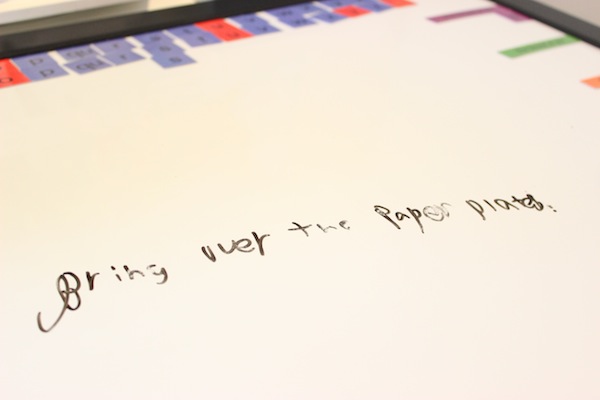
Sometimes my son prefers to write his sentences on the dry erase board — he still needs regular practice on paper, but the big-ness of the board is less intimidating to him.
The constant review and integration of past material ensures that there are no learning gaps — your student doesn’t forget the words learned last Friday because he is using the rules to build new words and sentences constantly.
#3. How They Feel About Their Spelling Is (Radically) Different
At the beginning of the year, I heard a lot of “I hate spelling”, “I hate reading,” and “I’m so bad at this!” I don’t hear any of that anymore.
Instead, I hear, “Is it a spelling day? No? Awwwwwww!” It’s true: He asks for spelling on our off-days (we do it three days a week)!
He breezes through his 15-20 minute lessons and delights in showing off his knowledge of the foundations of English to his older brother.
Not only does he feel good about spelling, he also feels good about his ability to decode and encode English. And most importantly he feels good about himself as a learner!
All About Spelling Is a Dream For Parent Educators
As a homeschooling parent who is not a trained educator (my degree is in political science!), All About Spelling is a dream to teach. Of the many homeschooling curricula I’ve used over the last 18 months, this is far and away my favorite.
It’s lightly scripted, so you can literally just open it up and go. Plus, there is almost no prep time required to teach a lesson.
(I did spend about 30 minutes preparing all the cards and tiles at the beginning of the first level. And then I spend another 10 minutes or so each Sunday afternoon reading through the three lessons I’ll be teaching that week.)
Best of all, the creators of this curriculum are there for you, as a teacher, 110%. I’ve emailed back and forth with them regarding a few questions I’ve had about their reading curriculum that we started using recently; they always get back to me within 24 hours with wonderfully detailed suggestions.
All About Spelling also offers a 100% money-back guarantee. I’m hard pressed to imagine any student who wouldn’t thrive using this curriculum, but rest assured that you have a full year to try it out and if it’s not working, they will refund your purchase price.
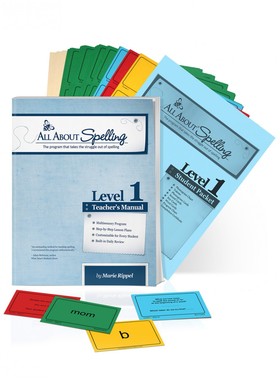
So, How Much Does All About Spelling Cost?
There are seven levels of All About Spelling in total; the first level costs $29.95 and each additional level costs $39.95.
This price includes the teacher’s manual and all the student materials needed to complete that level.
No matter what grade your child is in, I strongly recommend starting with the first level of All About Spelling. They will probably breeze thru it if they’re in 2nd grade or higher, but you definitely want to set that foundation and fill in any gaps first. (We finished the first level in 5 weeks, but the second level has taken us almost three and a half months to finish. I imagine level 3 will take even longer.)
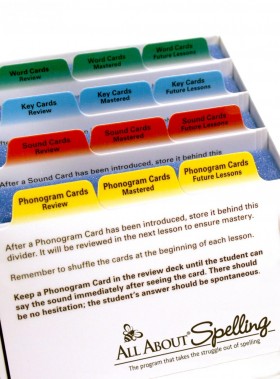
In addition to purchasing the teacher & student set for each level, you will also need to make a one-time purchase of the spelling interactive kit, which includes the magnetic tiles and the file box for the flash cards.
There are two versions of the kit — a more basic one and an upgraded one. Or, you can buy just the components that you want. If you go the component route, I recommend the following four items as essential:
- Letter Tiles – $11.95
- Magnets – $5.95
- Spelling Review Box – $9.95 (I didn’t get this at first, figuring I could just use a file card box. I quickly changed my mind and upgraded to this one, which is big enough to hold their cards for all seven levels)
- Spelling Divider Cards – $4.95
They also sell specialized stickers to use to use on the progress charts that come with each level. I didn’t buy them for Level 1 and just used stickers we had at home. I went ahead and purchased them for subsequent levels, since they’re only $1.
Tip: Don’t bother buying the phonogram CD, as they just released a free iTunes and Android app with all the sounds.
Shipping is not free and starts from around $9. If you buy more than one level or component piece at a time, the cost of shipping does increase, but only incrementally. I’ve realized that I can save a bit on shipping by ordering two levels at once, rather than just one at a time. So, although we’re just barely finishing level 2, I already have levels 3 and 4 at home.
The last purchase you’ll need to make before you get started is a 2’x3′ magnetic dry erase board to hold all your spelling tiles and serve as your work space.
I was eager to start, so I bought mine at Michael’s (using a 40% off coupon) for around $25; but you could probably stalk your Craigslist and find one for under $10. Just be sure that you buy one that’s magnetic!
Questions? I’d love to talk more about this amazing curriculum in the comments section, so let me know what’s on your mind!
Disclosure: I love All About Spelling so much that I signed up for their affiliate program, which means I earn a small commission if you choose to purchase through the links in this post. However, this review was not solicited, nor does my affiliate relationship impact my feelings about the program. For more information about the use of affiliate links, please see my disclosure policy.







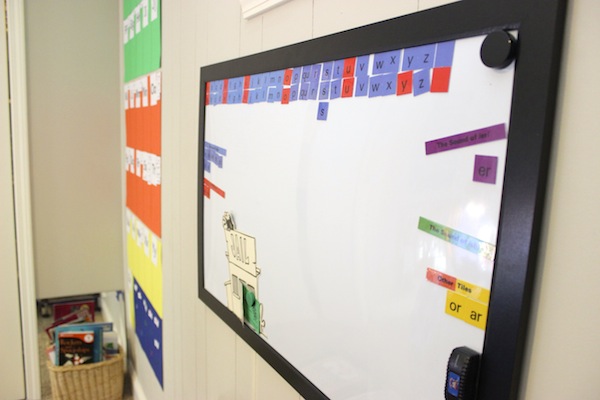
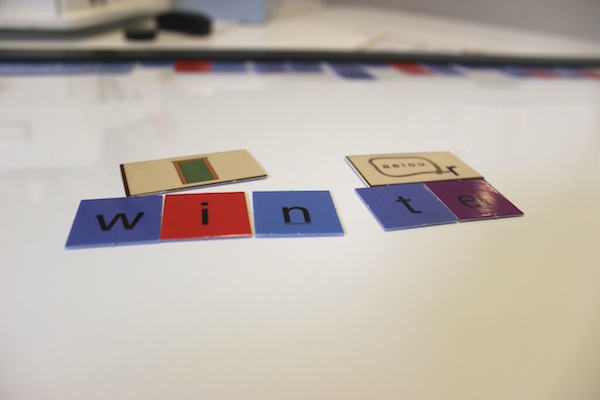
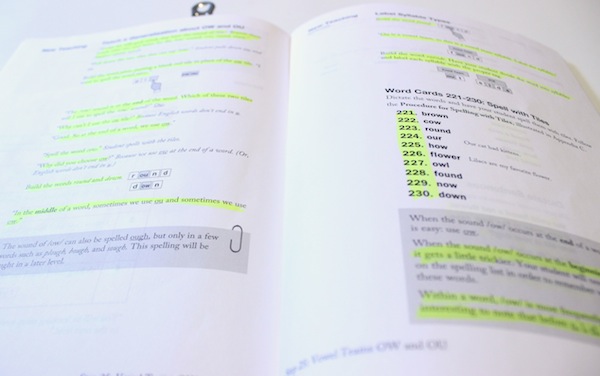









That is fantastic. I’ve actually heard rave reviews on this program from many long time homeschoolers in my community. So glad it is working so well!
Is the “All About Reading” program good as well?
Brocha – Yes, it’s wonderful! We started Level 3 (skipped 1 and 2) about 3 weeks ago and I’ve been very pleased with the results so far.
This review made me so excited to buy this program. Then once I got he the end of the purchase and realized my shipping was almost the same as my total I had a change of heart. I will do my best to create my own.
The KS for sharing the wonderful ideas though 🙂
I am looking forward to starting All About Spelling. When all levels are completed (1-7), What grade level would that be compared to?
Laura – That’s a great question and I didn’t know the answer, so I went to check on their site. According to their FAQ, it would be a high school level! http://www.allaboutlearningpress.com/faqs-for-all-about-spelling#high school level
We’re on Level 3 right now (just started) and what I’m finding is that some of the words my 2nd grader already knows how to spell from reading, so I use their “alternative words” suggestions. Rather than teaching word lists, it really teaches systems, so that your child can apply those systems across more challenging words as they get older and encounter harder words.
Hope that helps!
Hi! This sounds amazing! My children are not homeschooled, but 2 out of the 3 you described to a tee! Can I use this for them? Is there a way to incorporate their weekly spelling words into this?
So, we’re actually not homeschooling this year (life is always changing!). I am still using All About Spelling & All About Reading with my son, tho! We do it two or three times a week after school for about 20 minutes. It’s perfect for “after-schooling”. Let me know if you have any other questions.
My youngest will be 7 next week and I’m getting very frustrated with his lack of interest in learning how to read. I have a feeling he is dyslexic. He is still writing some letters and numbers backwards. He will see words like “on” and read it as “no”.
My 9 year old does not spell well at all.
I would like to try All about Reading and All about Spelling. I don’t know which one to get for each of them. Do I get reading and spelling for the 7 year old….and spelling for my 9 year ? Any insight would be great.
Toni – You should definitely start on Level 1, whichever program you choose. Even if it’s too easy at first, you need that foundation. We did Level 1 of AAS in about a month, but Level 3 took us about 9 months – by way of comparison. Learning the system, the sounds, etc. is essentially. We started with AAS, so that’s my inclination to recommend to you. I wouldn’t teach your boys together – do two separate 20 minute lessons. When there are varied levels, you really want to be able to work as much in depth as you can with each child. (Plus, I found that the bickering between my boys turned a 20 minute lesson into an hour-long lesson.)
Where did your get your “jail”?! 🙂 my son lives to find the rule breakers!
It came with my magnet set. Oh no! did you not get one?
Do you feel that particular sized magnet board is a must? We have a magnetic white board, but it’s a bit smaller at 16 x 20″
Not a must, but bigger gives you more room to move around the magnets, which is helpful. If you already have one, I would definintely use that — and if you feel that you need a bigger one, you can always ‘upgrade’. Good luck!